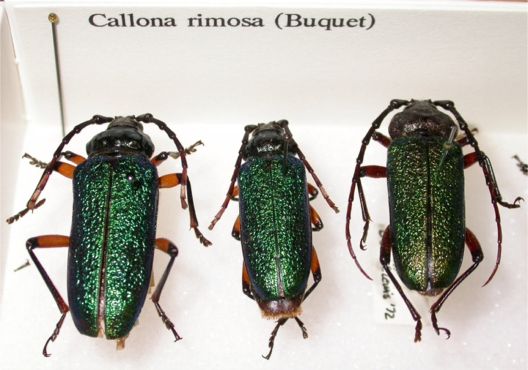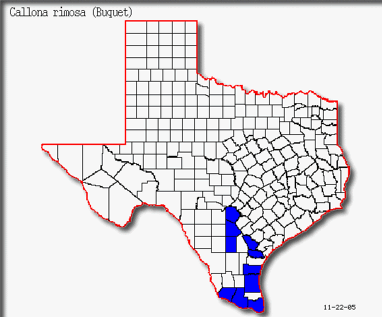
|
Return to Texas Entomology - Compiled by Mike Quinn

|

|
County Record Data from E.G. Riley, Nov. 2005
Range: South Texas to northern Mexico.
Adult Activity: March-July, most specimens from TAMUIC collected in April-May.
Larval Hosts: Larvae feed within the bases of living Mesquite (Prosopis) and Huisache (Acacia).
Similar Species: There are nine species of Callona, but only Callona rimosa reaches the United States.
Etymology: Callona rimosa
callio (G). More beautiful
callun (G). Adorn, beautify
rim, =a, -o (L). A fissure, split
References:
Arnett, R.H., Jr., M.C. Thomas, P. E. Skelley & J.H. Frank. (editors). 2002. American Beetles, Volume II: Polyphaga: Scarabaeoidea through Curculionoidea. CRC Press LLC, Boca Raton, FL. xiv + 861 pp.
Borror, D.J. 1960. Dictionary of Word Roots and Combining Forms. National Press Books, Palo Alto. v + 134 pp.
Hovore, F.T., R.L. Penrose & R.W. Neck 1987. The Cerambycidae, or longhorned beetles, of southern Texas: a faunal survey. Proceedings of the California Academy of Sciences, 44(13): 283-344, 20 figs.
Hudepohl, K.E. 1985. Revision der Trachyderini (Coleoptera: Cerambycidae, Cerambycinae). Entomol. Arb. Mus. George Frey, 33/34:1-167.
Monné, M.A. & F.T. Hovore. 2005. Electronic Checklist of the Cerambycidae of the Western Hemisphere. 393 pp.
Solomon, J.D. 1995. Guide to insect borers of North American broadleaf trees and shrubs. USDA Forest Service Handbook 706. Washington, DC. 735 pp.
Vogt, B.G. 1949. Notes on Cerambycidae from the Lower Rio Grande Valley, Texas. Pan-Pacific Entomologist 25(3):137-144; (4):175-184.
08 Jul 2007 © Mike Quinn / mike.quinn@tpwd.state.tx.us / Texas Entomology / Texas Beetle Information